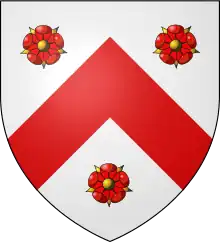Ogilvy-Wedderburn baronets
The Wedderburn, later Ogilvy-Wedderburn Baronetcy, of Balindean in the County of Perth, is a title in the Baronetage of the United Kingdom created in 1803.

The third Baronet sat as Member of Parliament for Ayrshire South and Haddington Burghs while the fourth Baronet represented Banffshire in Parliament as a Liberal. On the latter's death in 1918 the title was inherited (according to the special remainder) by his kinsman John Andrew Ogilvy-Wedderburn, the fifth Baronet, who had assumed the surname of Ogilvy-Wedderburn the same year. He was a descendant of James Wedderburn-Colville, youngest son of the fifth Baronet of the 1704 creation. His grandfather Peter Wedderburn had in 1811 married Anna, daughter and heiress of James Ogilvy, and assumed the surname of Wedderburn-Ogilvy on the death of his father-in-law in 1826.
Revival of Wedderburn title
The baronetcy is a revival of an earlier title held by the family, which had been forfeited in 1746 following the 1745 Rebellion. On 18 August 1803 David Wedderburn, "7th Baronet of Balindean" (but for the attainder), was created a baronet, of Balindean in the County of Perth, in the Baronetage of the United Kingdom, with remainder, failing heirs male of his own, to the heirs male of the fourth Baronet of the 1704 creation. Sir David later represented Perth Burghs in the House of Commons and served as Postmaster-General for Scotland.
Wedderburn, later Ogilvy-Wedderburn baronets, of Balindean (1803)
- Sir David Wedderburn, 1st Baronet (1775–1858)[1]
- Sir John Wedderburn, 2nd Baronet (1789–1862)[1]
- Sir David Wedderburn, 3rd Baronet (1835–1882)[1]
- Sir William Wedderburn, 4th Baronet (1838–1918)[2]
- Sir John Andrew Ogilvy-Wedderburn, 5th Baronet (1866–1956)[3]
- Sir (John) Peter Ogilvy-Wedderburn, 6th Baronet (1917–1977)[4]
- Sir Andrew John Alexander Ogilvy-Wedderburn, 7th Baronet (born 1952)[5]
The heir apparent to the baronetcy is Peter Robert Alexander Ogilvy-Wedderburn (born 1987), eldest son of the 7th Baronet.[5]
Balindean
The place-name associated with the baronetcy is Balindean; the place itself is now spelled Ballindean. The estate lies near Inchture, a village between Dundee and Perth on the northern side of the Firth of Tay.[6] In 1769 it was purchased by John Wedderburn,[7][8] who had rebuilt the family fortune by slave sugar plantations in Jamaica.
In 1820 his son, the 1st baronet sold the Balindean estate to William Trotter, later Lord Provost of Edinburgh, for £67,000.[9] The Wedderburn baronets had no further connection with Balindean, other than in the place-name associated with the title.
The Ballindean House (NB spelling), the listed building visible today, is an 1832 rebuild.[10][11][12]
See also
Notes
- Foster, Joseph (1883). The Baronetage and Knightage of the British Empire. Westminster: Nichols and Sons. pp. 647–648.
- "Wedderburn, Sir William". Who's Who. A & C Black. (Subscription or UK public library membership required.)
- "Ogilvy-Wedderburn, Sir John Andrew". Who's Who. A & C Black. (Subscription or UK public library membership required.)
- "Ogilvy-Wedderburn, Comdr Sir (John) Peter". Who's Who. A & C Black. (Subscription or UK public library membership required.)
- "Ogilvy-Wedderburn, Sir Andrew John Alexander". Who's Who. A & C Black. (Subscription or UK public library membership required.)
- "Ballindean House | ScotlandsPlaces". scotlandsplaces.gov.uk. Retrieved 3 August 2018.
- "WEDDERBURN, Sir David, 1st Bt. (1775-1858), of Ballindean, Perth. | History of Parliament Online". historyofparliamentonline.org. Retrieved 9 April 2020.
- "John Wedderburn of Balindean Profile & Legacies Summary". Legacies of British Slave-ownership. Retrieved 9 April 2020.
- Jackson, Stephen (2006). "William Trotter, 1772-1833". The Book of the Old Edinburgh Club. Retrieved 9 April 2020.
- "Ballindean House, Inchture, Perth and Kinross". britishlistedbuildings.co.uk. Retrieved 9 April 2020.
- "Ballindean House, Canmore". canmore.org.uk. Retrieved 9 April 2020.
- "Ballindean House, ScotlandsPlaces". scotlandsplaces.gov.uk. Retrieved 1 February 2018.